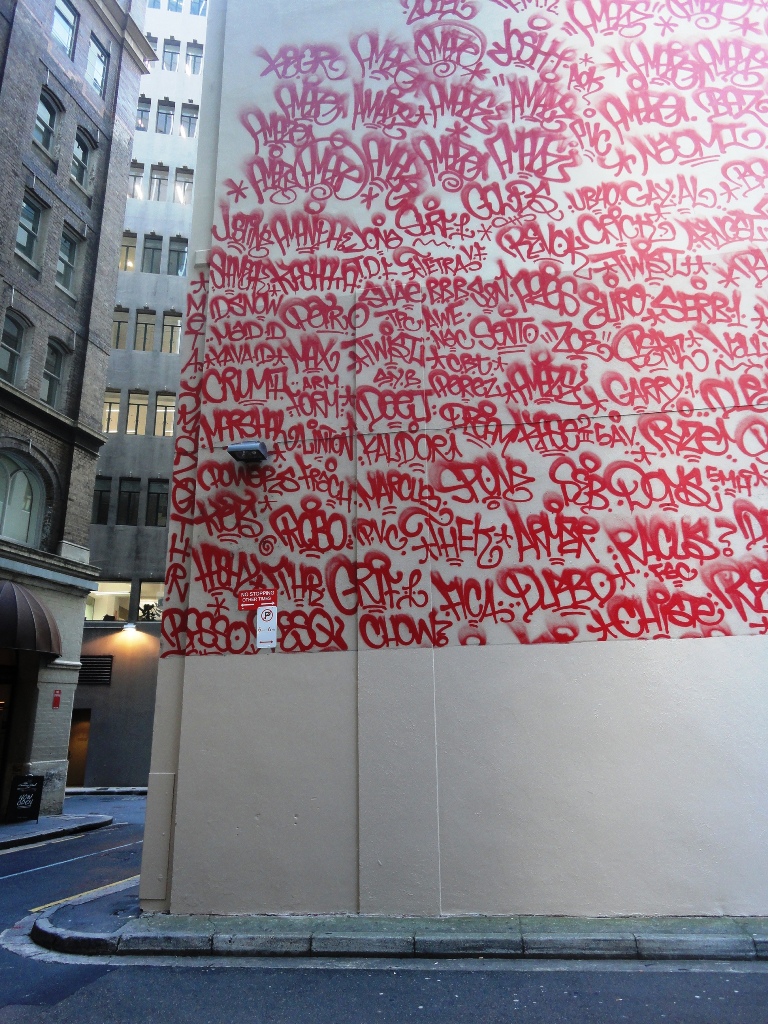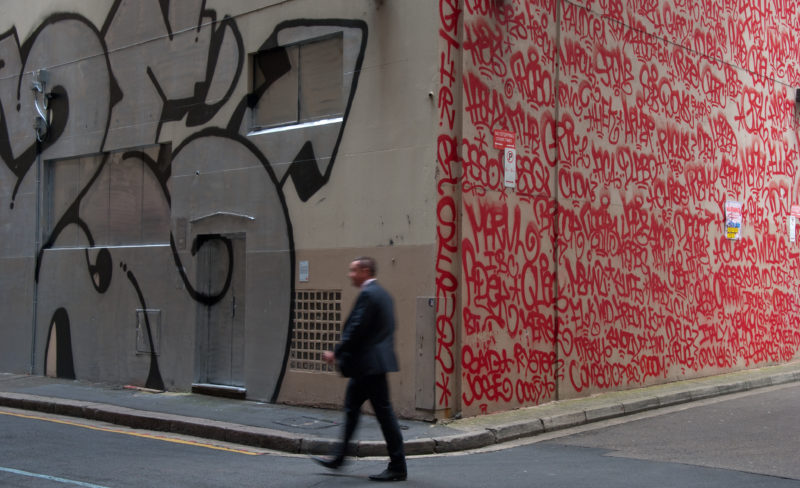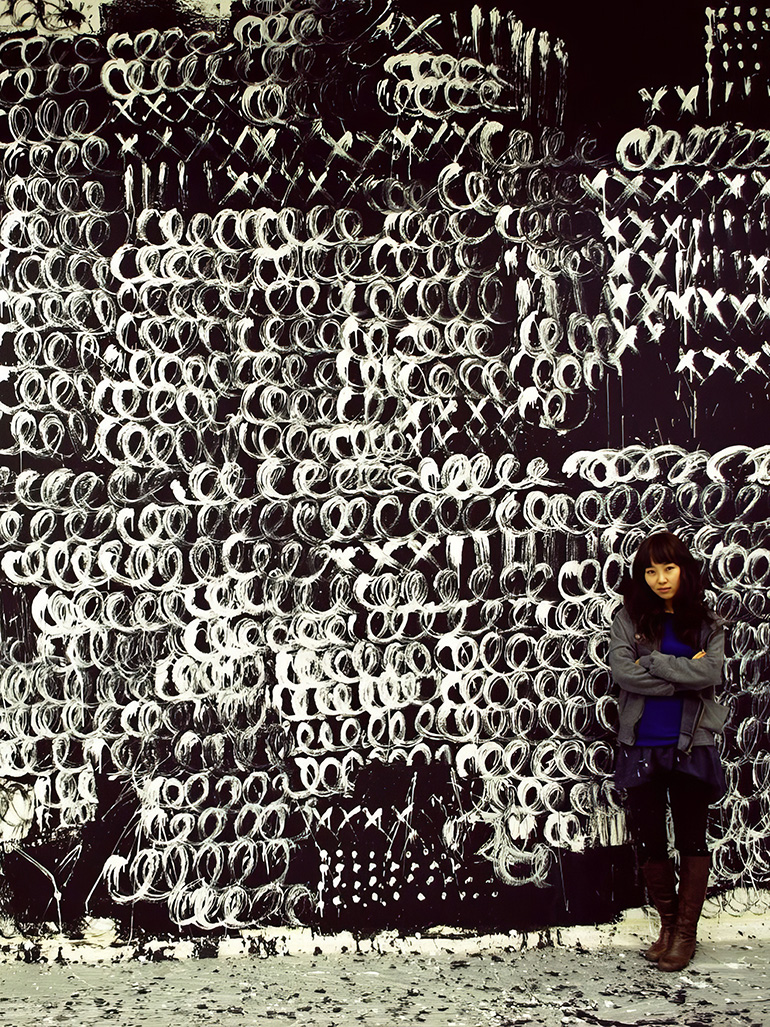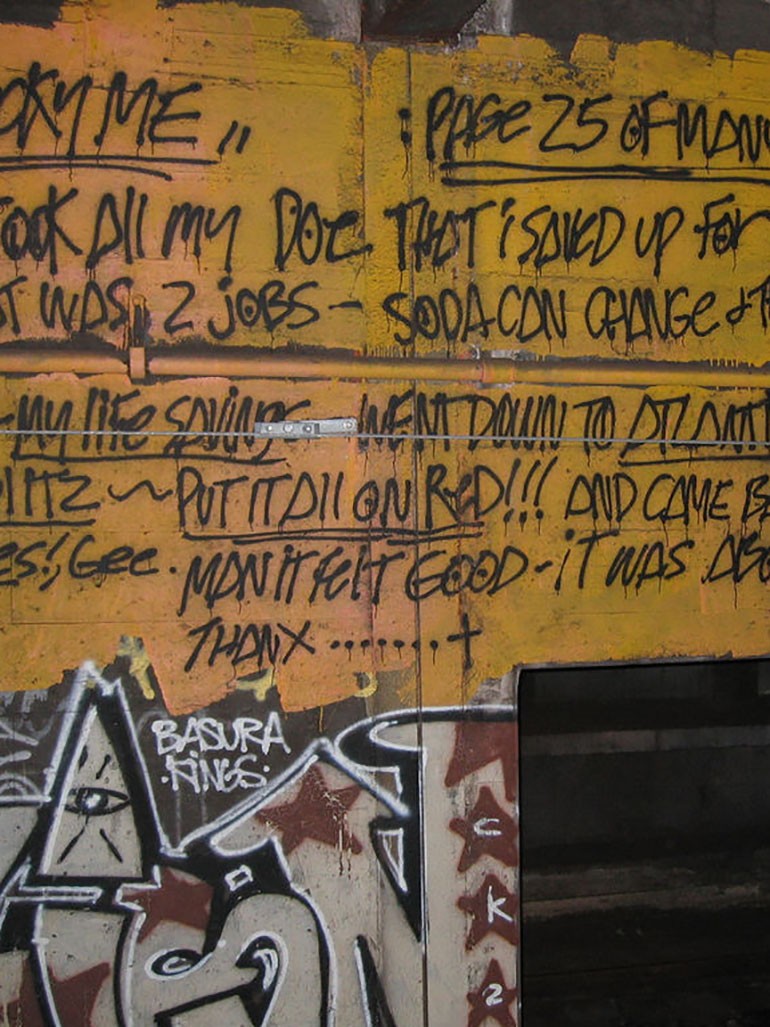
Barry McGee’s tag mural in New York
When the iconic gallerist Jeffrey Deitch swapped the East Coast for West Coast, many wondered about the state of street art in New York City. Granted, the newer generation of gallerists such as Joshua Liner and Jonathan Levine had become preeminent curators with their fresh take on street art. However, with his unlimited resources, Deitch still reigns supreme in most people’s minds.

But all that changed when artists in August 2010, Barry McGee 1 (aka Twist) and Josh Lazcano 2 (aka Amaze), descended on New York with an ambitious project yet on the new exalted wall between Houston Street and Bowery on the Lower East Side.

San Francisco-based graffiti artist Barry McGee created a homage to all graffiti writers, covering New York’s 3 iconic corner of Houston & Bowery with hundreds of red tags, shout-outs to names and crews of different graffiti writers.
Assisted by his friend and assistant Josh Lazcano, McGee worked throughout the night into the early hours of the morning to complete this unusual mural that he hoped would last long enough for the New Yorkers to enjoy.

The idea was simple – tag as many graffiti writers as possible. However, the actual job was anything but. With more to do and little time to do it, the two writers worked in a hurried yet familiar pace to the present day, down to their cursive signatures. Despite attracting the attention of the New York Police Department on several occasions, the two managed to complete the project nonetheless.
By dawn, the team had created the ultimate graffiti writer’s roll call and a strangely beautiful, albeit challenging, piece of commissioned graffiti art. The resulting mural was more astounding than the two artists could have imagined.

A few days later, the mural began to attract mixed reactions and it was only a matter of days before questions began to emerge. The first reaction was from the police, who made the first visit to the site at around 2 am. At first, the police could not believe what they were seeing:
No, this couldn’t be legit. This couldn’t be art.
But after a short intervention, a permit was produced and the police left the site.

With a little help from Chino, McGee and Lazcano had completely filled in the building wall. The crowd that had assembled around the wall had left, leaving the artists with ample space to “touch up” a couple of things. But soon, the two artists received another interruption when a carload of young club ladies hijacked the sidewalk for a private photo shoot in the company of the Baltimore-born American photojournalist Martha Cooper 4.
Barry and his crew appeared in several frames, although this was far from what they would have liked for publicity. By around 5 am, the street would soon be blocked off by the fire department and the police after an accident involving an SUV and the graffiti-adorned box truck standing by the sidewalk. This brought more unwanted attention to the wall.

Initially, Tony Goldman had acquired ownership of the Houston Street wall and used it solely for advertisements. But in 2008, in celebration of artist Keith Haring’s 5 50th birthday, Goldman donated the wall to curator and friend Jeffrey Deitch, who commissioned Gotham Scenic to recreate Haring’s original 1982 classic.
In the summer of 2009, Brazilian street duo Os Gemeos 6 was invited by Deitch projects and Goldman Properties to create a meticulously illustrated mural on the wall. Later, the twins would work with Goldman and Deitch in Miami on the Wynwood Walls project.

The next artist to create work on the iconic wall was Shepard Fairey 7, Deitch’s friend. A casing was placed over the wall to shield the previous Os Gemeos work and the new wall functioned as a canvas for Shepard’s design-heavy work in 2010. The Fairey work was timed to promote the artist’s May Day installation, the final show at Deitch Projects.
But Deitch and Fairey know that the new wall would be a target for New York City graffiti writers. Therefore, they hired security to guard the freshly completed project.
The Hole became the successor gallery after Jeffery Deitch closed up shop and became the director of the Museum of Contemporary Art in Los Angeles. The first wall project by The Hole was a collaboration with Barry McGee and Josh Lazcano. In 2010, they used the iconic wall to pay homage to legendary graffiti writers from both yesterday and today.
Kenny Scharf, JR, Faile 8 and Retna are amongst other artists who have since created artworks on the wall.
Location
Location
76 E Houston St, New York, NY 10012
Video: Barry McGee speaks about tagging
4 min 19 sec
Tag Mural in Sydney, Australia, 2011-2012
Tag Mural in Sydney, Australia, 2011-2012
In 2011, McGee was commissioned for the Laneway Art program, where he first created a tag mural in Tank Stream Way, opposite the entrance to Bridge Lane. In silver and black outlines, the graffiti-style painting reached up to two stories high and covered a doorway and several other windows.

To access the work, the audience was forced to retreat down Bridge Lane not only to interact with the art but also to become part of the action on the street. While producing this artwork, the artist provocatively created a second, uncommissioned at the same site adjacent to Pitt Street.

This new work features a collection of red tags reaching more than two and a half stories high. To be able to read some of the tags, viewers needed to come close to the wall. After negotiating with the building owners, the second mural was included in the Laneway Art program.

These two artworks bridged the divide between his gallery practice and street art, functioning not only as paintings but also as personal marks for McGee, emphasizing his presence not only in the art world but also on the street.




Location
Installed between 23 September 2011 – 31 January 2012
In Tank Stream Way adjacent to Pitt Street, Sydney
NSW 2000, Australia
About the artist
McGee is a San Francisco-based artist known by a number of nicknames, including Bernon Vernon, Ray Fong, and variations of Twist, including Twister, Twisto, and Twisty.
Throughout McGee’s work, he fused together found and invented imagery, tags, and assorted objects drawn from a range of influences, such as tramp art, Mexican muralists, the San Francisco Beat poets, and the graffiti artists of the 1970s and 1980s, to create a unique visual language.
Explore nearby
Bowery Mural, New York

 Tony Rosenthal’s Astor Place Cube1 km away
Tony Rosenthal’s Astor Place Cube1 km away Karl Haendel's scribble muralsInstallation ended (dismantled in 2009)1 km away
Karl Haendel's scribble muralsInstallation ended (dismantled in 2009)1 km away Snarkitecture's SwayExhibition ended (dismantled in 2019)2 km away
Snarkitecture's SwayExhibition ended (dismantled in 2019)2 km away Isamu Noguchi's Red Cube sculpture2 km away
Isamu Noguchi's Red Cube sculpture2 km away









